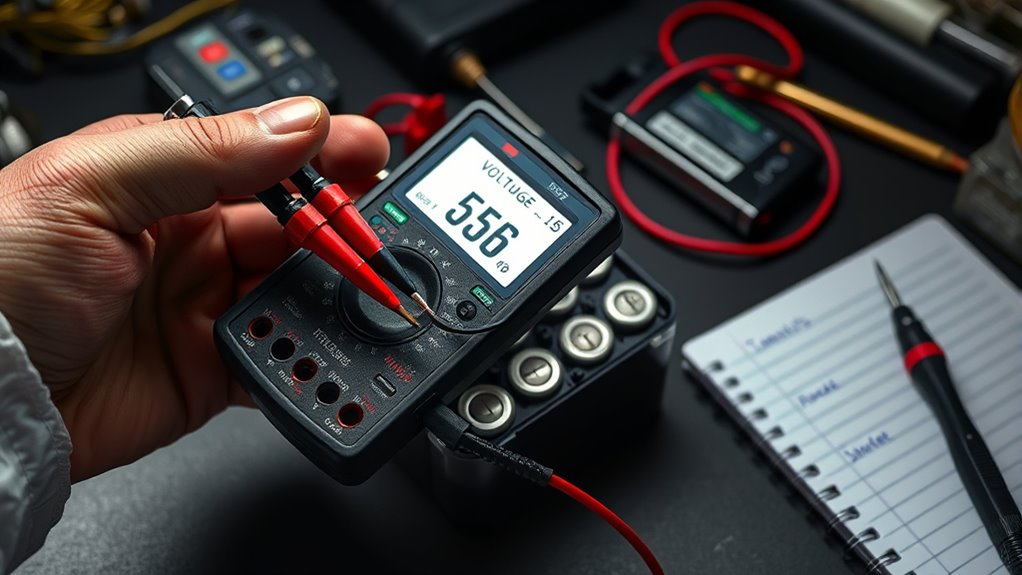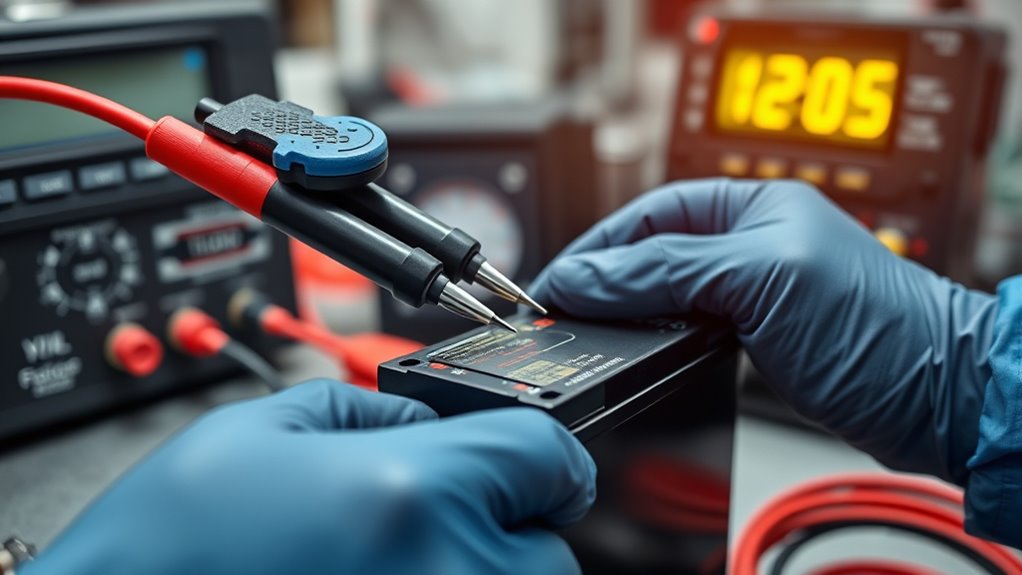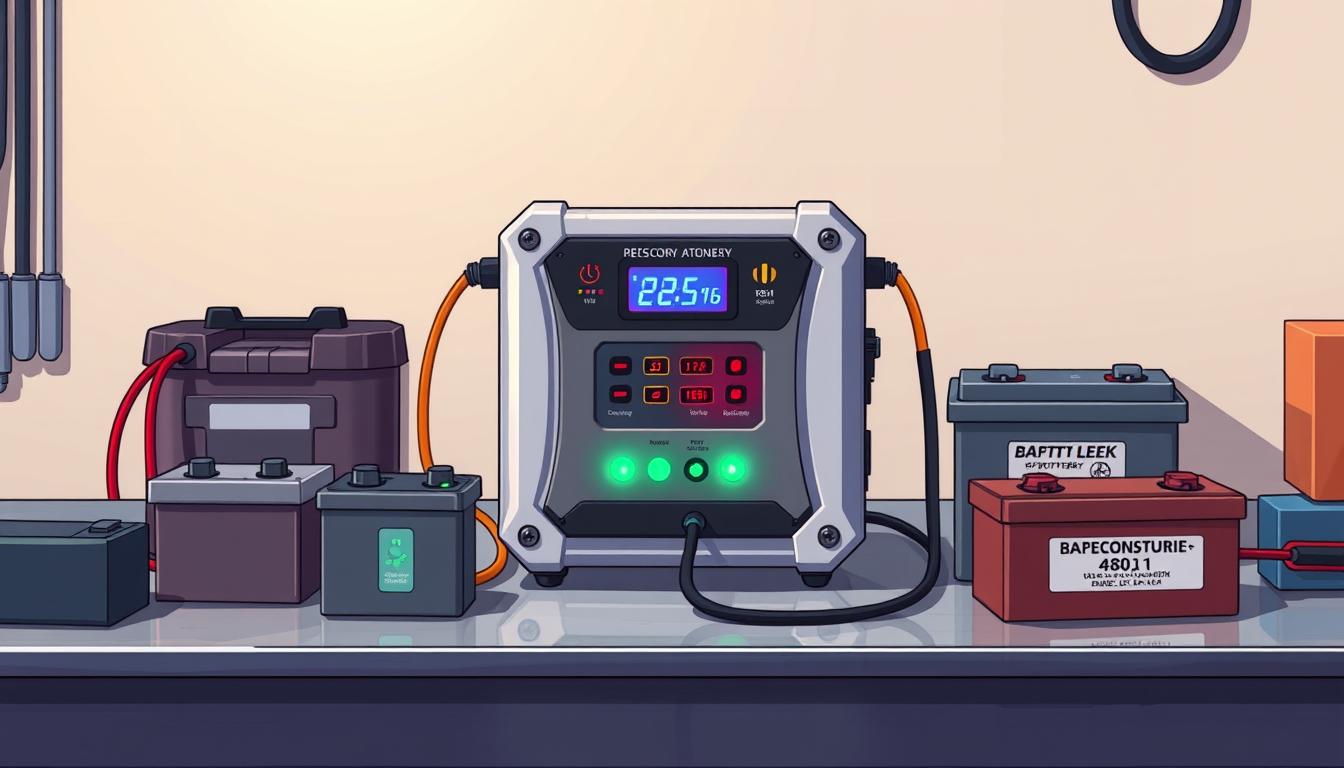To assess your battery’s health before reconditioning, start by measuring its voltage with a multimeter—aim for around 12.6V or higher when fully charged. Then, consider capacity testing to see how much current it can hold over time, revealing internal deterioration. Both tests together give a clearer picture of whether the battery can be effectively revived or if replacement is needed. Continue exploring to learn more essential testing tips and methods.
Key Takeaways
- Measure voltage with a multimeter; a healthy fully charged battery reads around 12.6V or higher.
- Voltage testing indicates overall charge but doesn’t reveal internal health or capacity.
- Conduct capacity testing to determine how much current the battery can reliably deliver over time.
- Low voltage combined with poor capacity suggests internal deterioration and potential end-of-life.
- Using both voltage and capacity tests provides a comprehensive assessment for informed reconditioning decisions.

Have you ever wondered how healthy your vehicle or device’s battery really is? Before jumping into reconditioning or replacing it, it’s vital to assess its current state of charge and overall health. These measurements give you a clear picture of how well your battery is functioning and whether it’s worth investing time and resources into restoring it. Understanding the state of charge helps you determine how much energy your battery can still hold, while checking for voltage deterioration reveals how much its performance has declined over time.
When testing your battery, start by measuring its voltage with a multimeter. A healthy, fully charged car battery, for example, should read around 12.6 volts or higher. When the engine is running, this voltage should increase to approximately 13.7 to 14.7 volts, indicating that the alternator is charging the battery properly. If your readings are noticeably lower, it suggests that the battery may have a diminished capacity or is experiencing voltage deterioration, meaning it can’t hold a sufficient charge anymore. This decline often results from aging, repeated deep discharges, or exposure to extreme temperatures. Voltage testing is quick and provides immediate insight into the battery’s condition, but it’s not the sole indicator.
To get a more accurate idea of your battery’s health, you need to perform capacity testing. This involves monitoring how much current your battery can deliver over a specified period. Capacity testing can be more involved, often requiring specialized equipment, but it’s the best way to determine if your battery can still reliably power your device or vehicle. If your capacity is notably below the manufacturer’s specifications, it indicates that the battery has deteriorated internally and may soon fail. This is especially true if the voltage readings during testing show consistent drops or fail to reach normal levels under load.
Capacity testing reveals internal battery deterioration and potential failure if performance falls below manufacturer specs.
Keep in mind that a high voltage reading alone isn’t enough to confirm a healthy battery, as voltage can sometimes temporarily appear normal even if the internal chemistry has degraded. Conversely, a low voltage might not always mean immediate failure if the battery is just partially discharged. That’s why combining voltage measurements with capacity testing provides a detailed view. If you detect signs of voltage deterioration or a low state of charge, you’ll have a clearer basis for deciding whether reconditioning is viable or if replacing the battery is the smarter choice. Proper testing ensures you don’t waste effort on a battery that’s beyond saving, saving you time and money in the long run. Additionally, understanding battery technology helps you interpret test results more accurately and make informed decisions.
Frequently Asked Questions
How Often Should I Test My Battery’s Health?
You should test your battery’s health every 3 to 6 months to monitor its lifespan and performance. Regular testing helps you catch potential issues early, ensuring it stays reliable. If you notice symptoms like reduced runtime or difficulty holding a charge, increase testing frequency. Keeping track of your battery’s condition allows you to decide when reconditioning might be necessary, extending its useful life and avoiding unexpected failures.
Can Voltage Testing Alone Determine Battery Capacity?
Ever wondered if voltage testing alone can truly reveal your battery’s capacity? It can’t because voltage accuracy only provides a rough estimate, not a complete picture. While voltage tests help gauge general health, they don’t precisely measure capacity, which requires capacity estimation through additional testing. Relying solely on voltage might leave you with an inaccurate idea of your battery’s actual performance, so combine methods for a thorough assessment.
What Tools Are Best for Accurate Capacity Measurement?
You should use reliable battery analyzers or capacity testers for accurate capacity measurement. These tools provide precise readings of a battery’s true capacity, helping you determine its health. Battery analyzers are user-friendly and often feature digital displays, making it easy to assess performance at a glance. Investing in quality capacity testers guarantees you get an accurate picture of whether a battery needs reconditioning or replacement.
How Do Temperature Variations Affect Test Results?
You might think temperature fluctuations don’t matter, but they can substantially impact test accuracy. When it’s too cold or hot, battery performance appears worse or better than it truly is, skewing your results. To get reliable readings, perform tests in a stable environment, ideally between 20-25°C. This minimizes temperature effects, ensuring your capacity and voltage measurements accurately reflect the battery’s health and helps you make better reconditioning decisions.
Is Professional Testing Necessary for Accurate Assessment?
Professional testing isn’t always necessary, but it’s highly recommended for accurate battery diagnostics. You might get reliable results with basic voltage and capacity tests, but experts use specialized equipment to identify subtle issues and overall health. If your battery’s performance is critical, investing in professional testing guarantees precise assessments, helping you decide whether reconditioning is worthwhile or if replacement might be the better option.
Conclusion
Understanding battery voltage and capacity is essential before reconditioning, ensuring you don’t waste time or risk damage. Did you know that nearly 70% of battery failures are due to capacity loss rather than voltage issues? By accurately testing these parameters, you can extend your battery’s lifespan and save money. So, take the time to assess its health properly—your battery will thank you, and you’ll enjoy reliable performance longer.










